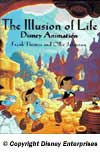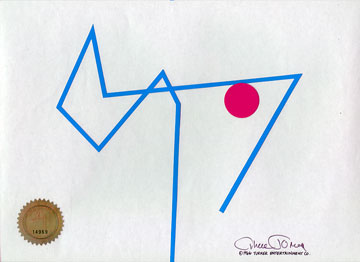Because a Cartoon Moves Doesn't Mean It Connects
A lot of web cartoons are flat and lifeless, is it because they are created in Flash? Well, yes that is probably one reason. But it isn't inherently a flaw in Flash that causes this problem but rather its availability and ease of usage. We often tend to forget that without a production environment like Flash and a distribution platform like the Internet that tens of thousands of web cartoons would not even have ever been made. It has certainly opened up a communications medium to millions of people.
For all its shortcomings, Flash has enabled massive numbers of would be cartoon makers to be able to publish their work. This is not a bad thing but it does create a lot of poorly done cartoons along with some real diamonds too.
Moving objects around on a screen is not animation in the true sense of the word. It is motion. Animation actually means to give life, to impart that spark which connects with a viewer's imagination and emotions and transforms art.
In order for a cartoonist to create life they must translate their own emotions into their art. It isn't a technology thing. In fact, if you think about it for a moment, technology is a tool and a barrier.
Traditionally, a cartoonist is story teller that uses graphical art as a vehicle. But a cartoonist is much more than just a graphical artist; we are also performing artists, and actors. We play many roles in our cartoons, one for each character. Traditionally actors use their bodies as the instrument of their performance. A cartoon director / animator uses their pencil. But the emotional connection has to be the same. For an actor movement of their body, their body language, must be developed if they are to be able to communicate emotions. For an animator their drawing skills must be developed if they are to be able to communicate their emotions.
It is a wonderful gift that Flash and the Internet bring to the cartoonist; they enable us to deliver content. But the content itself must come from the artist. The challenge is to discover our own voice and to translate our emotions via this relatively new medium.
Where do we begin? Well unfortunately for most web cartoonists the beginning is producing a cartoon. It would be like a person deciding that they wanted to be an actor and their first attempt to act is to write, produce and star in a three act play. Some truly gifted individuals might actually pull that off, but most actors would be more successful just trying to play a small part in a simple scene. The same is true for a new cartoonist; we must start small and develop our acting skills in small steps.
What's the first step for most beginning cartoonists? Well it should be to try to convincingly create life in an inanimate object. It doesn't have to be a complex object, in fact the simpler the better. It could be a letter from the alphabet or a ball, or a cube, or a sack of flour. But until you can make that simple object capable of translating your emotions to an audience you aren't really animating you are just making things move on the screen.

“The Dot and the Line", Chuck Jones’ award winning short, is an example of this ability to connect emotionally thru the simplest of inanimate objects. This is an amazing animated cartoon that took a brilliant story from a book and brought it to life. This is a great piece to study for anyone wanting to understand the creative power of skilled animators.
I see a lot of discussions in Internet forum sites where people get all excited about a still picture that someone drew or painted. Or they argue endlessly about doing frame by frame animation and how Flash “tweens” don't look good. Or they rant and rave on about having or not having a graphics tablet. But there seems to be a huge void in discussion about actually creating work that connects with an audience or that conveys feelings.
It seems that many people confuse how realistic something looks or how close something looks to live action with good animation. Let's face it; realism and realistic movement in and of themselves are important to simulation but not animation. If you are trying to simulate the real world this may be an important objective but most simulations may be informative but aren't usually classified as entertaining.
Now I will admit that in a strict definition of animation that it doesn't have to be entertaining. But for the focus of this article we are assuming that most people want to be entertained when they watch a cartoon. Motion graphics and flying titles may be interesting or they may catch your eye, or at least add something extra to a web site besides static pictures and text but they hardly rank as entertaining or capable of emotionally connecting with anyone.
Most artwork is representational. It is analogous to something but it is by no means realistic. And the same is true in animation, characters and their movement is representational. Too many people get so tied up in the look, that they miss the point.
If your animation is believable then you are connecting with an audience. But believable has nothing to do with realistic. Believable means that the viewer relates to what you are presenting with their own experiences and feelings and they are relaxing their perception of reality enough to include your representation. You have made a connection and your work is communicating feelings.
Character personality is an absolute requirement in making an emotional connection. So perhaps we should explore, what is personality? I guess our usual definition of personality is that which makes an individual seem unique and interesting. It is a differentiation between how we perceive others. At least that's the uniqueness part but what about the interesting part? Things can be different without always being interesting so perhaps that is a key to what really drives a sense of personality. To be interesting something must attract our interest, awaken our curiosity or at least make us take notice. So what drives our interests?
We are usually interested in things that we find important that we can identify with and to which we can relate. So a character's personality must have aspects with which we can identify. They might be our own characteristic or the characteristics we aspire to possess or the characteristics we try to suppress.

Again, Chuck Jones the great cartoon director talks a lot about characters and personality in the books that he wrote. If you have never read "Chuck Amuck" or "Chuck Reducks" you really are missing a treat. Not only was Chuck a great cartoon creator he was as funny in person as his creations were on the screen. And he was a most insightful writer about the subject of cartoon making. His books are master works of intellectual insight and treasures of knowledge for future generations of creators.
As I was saying Chuck Jones often remarked that he worked with cartoon characters that were personalities not drawings. They acted and reacted as personalities. They could play a role in a cartoon but they also played it true to their own nature. Chuck always said that Bugs Bunny had characteristics to which he as a cartoonist aspired, where as Daffy Duck said and did what most of us think although we don't always say or do. There is a lot of insight in those descriptions.
Think about a character like Pepe LePew. He isn't funny or interesting because he's a skunk. He's funny and interesting because he thinks and acts like he is this great lover. He is totally oblivious to his short comings and can only see himself in the light of his own self view certainly not as he is viewed by the world. That's a real personality. We all know people just like that. Maybe we even have a little Pepe in ourselves.
So the secret to creating living thinking characters is not how funny you draw them or how great you make them move, it is how they act and react. Until your characters evolve in your mind from being characters you created into characters who's adventures you are chronicling they aren't connecting with you and they won't connect with your audience.
For all its shortcomings, Flash has enabled massive numbers of would be cartoon makers to be able to publish their work. This is not a bad thing but it does create a lot of poorly done cartoons along with some real diamonds too.
Moving objects around on a screen is not animation in the true sense of the word. It is motion. Animation actually means to give life, to impart that spark which connects with a viewer's imagination and emotions and transforms art.

In order for a cartoonist to create life they must translate their own emotions into their art. It isn't a technology thing. In fact, if you think about it for a moment, technology is a tool and a barrier.
Traditionally, a cartoonist is story teller that uses graphical art as a vehicle. But a cartoonist is much more than just a graphical artist; we are also performing artists, and actors. We play many roles in our cartoons, one for each character. Traditionally actors use their bodies as the instrument of their performance. A cartoon director / animator uses their pencil. But the emotional connection has to be the same. For an actor movement of their body, their body language, must be developed if they are to be able to communicate emotions. For an animator their drawing skills must be developed if they are to be able to communicate their emotions.
It is a wonderful gift that Flash and the Internet bring to the cartoonist; they enable us to deliver content. But the content itself must come from the artist. The challenge is to discover our own voice and to translate our emotions via this relatively new medium.
Where do we begin? Well unfortunately for most web cartoonists the beginning is producing a cartoon. It would be like a person deciding that they wanted to be an actor and their first attempt to act is to write, produce and star in a three act play. Some truly gifted individuals might actually pull that off, but most actors would be more successful just trying to play a small part in a simple scene. The same is true for a new cartoonist; we must start small and develop our acting skills in small steps.
What's the first step for most beginning cartoonists? Well it should be to try to convincingly create life in an inanimate object. It doesn't have to be a complex object, in fact the simpler the better. It could be a letter from the alphabet or a ball, or a cube, or a sack of flour. But until you can make that simple object capable of translating your emotions to an audience you aren't really animating you are just making things move on the screen.

“The Dot and the Line", Chuck Jones’ award winning short, is an example of this ability to connect emotionally thru the simplest of inanimate objects. This is an amazing animated cartoon that took a brilliant story from a book and brought it to life. This is a great piece to study for anyone wanting to understand the creative power of skilled animators.
I see a lot of discussions in Internet forum sites where people get all excited about a still picture that someone drew or painted. Or they argue endlessly about doing frame by frame animation and how Flash “tweens” don't look good. Or they rant and rave on about having or not having a graphics tablet. But there seems to be a huge void in discussion about actually creating work that connects with an audience or that conveys feelings.
It seems that many people confuse how realistic something looks or how close something looks to live action with good animation. Let's face it; realism and realistic movement in and of themselves are important to simulation but not animation. If you are trying to simulate the real world this may be an important objective but most simulations may be informative but aren't usually classified as entertaining.
Now I will admit that in a strict definition of animation that it doesn't have to be entertaining. But for the focus of this article we are assuming that most people want to be entertained when they watch a cartoon. Motion graphics and flying titles may be interesting or they may catch your eye, or at least add something extra to a web site besides static pictures and text but they hardly rank as entertaining or capable of emotionally connecting with anyone.
Most artwork is representational. It is analogous to something but it is by no means realistic. And the same is true in animation, characters and their movement is representational. Too many people get so tied up in the look, that they miss the point.
If your animation is believable then you are connecting with an audience. But believable has nothing to do with realistic. Believable means that the viewer relates to what you are presenting with their own experiences and feelings and they are relaxing their perception of reality enough to include your representation. You have made a connection and your work is communicating feelings.
Character personality is an absolute requirement in making an emotional connection. So perhaps we should explore, what is personality? I guess our usual definition of personality is that which makes an individual seem unique and interesting. It is a differentiation between how we perceive others. At least that's the uniqueness part but what about the interesting part? Things can be different without always being interesting so perhaps that is a key to what really drives a sense of personality. To be interesting something must attract our interest, awaken our curiosity or at least make us take notice. So what drives our interests?
We are usually interested in things that we find important that we can identify with and to which we can relate. So a character's personality must have aspects with which we can identify. They might be our own characteristic or the characteristics we aspire to possess or the characteristics we try to suppress.

Again, Chuck Jones the great cartoon director talks a lot about characters and personality in the books that he wrote. If you have never read "Chuck Amuck" or "Chuck Reducks" you really are missing a treat. Not only was Chuck a great cartoon creator he was as funny in person as his creations were on the screen. And he was a most insightful writer about the subject of cartoon making. His books are master works of intellectual insight and treasures of knowledge for future generations of creators.
As I was saying Chuck Jones often remarked that he worked with cartoon characters that were personalities not drawings. They acted and reacted as personalities. They could play a role in a cartoon but they also played it true to their own nature. Chuck always said that Bugs Bunny had characteristics to which he as a cartoonist aspired, where as Daffy Duck said and did what most of us think although we don't always say or do. There is a lot of insight in those descriptions.
Think about a character like Pepe LePew. He isn't funny or interesting because he's a skunk. He's funny and interesting because he thinks and acts like he is this great lover. He is totally oblivious to his short comings and can only see himself in the light of his own self view certainly not as he is viewed by the world. That's a real personality. We all know people just like that. Maybe we even have a little Pepe in ourselves.
So the secret to creating living thinking characters is not how funny you draw them or how great you make them move, it is how they act and react. Until your characters evolve in your mind from being characters you created into characters who's adventures you are chronicling they aren't connecting with you and they won't connect with your audience.

0 Comments:
Post a Comment
<< Home